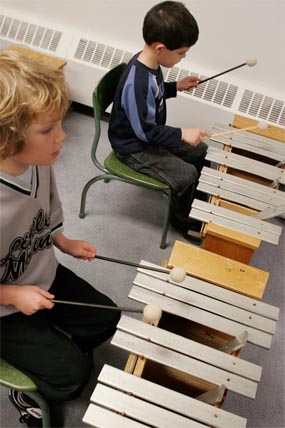The Orff Approach

The Orff Method is a way of teaching children about music that engages their mind and body through a mixture of singing, dancing, acting and the use of percussion instruments (i.e. xylophones, metallophones, glockenspiels). Lessons are presented with an element of "play" helping the children learn at their own level of understanding.
What is Orff-Schulwerk?
Also known as the Orff Method, Orff Approach or Music for Children; it is a way of introducing and teaching children about music on a level that they can easily comprehend. Musical concepts are learned through singing, chanting, dance, movement, drama and the playing of percussion instruments. Improvisation, composition and a child's natural sense of play are encouraged.
Who created the Orff Approach?
This approach to music education was developed by Carl Orff, a German composer, conductor and educator whose most famous composition is the oratorio "Carmina Burana." It was conceived during the 1920s and 1930s while he served as music director of the Günther-Schule; a school of music, dance and gymnastics that he co-founded in Munich. His ideas were based on his belief in the importance of rhythm and movement. Orff shared these ideas in a book titled Orff-Schulwerk which was later revised and then adapted into English as Music for Children.
What types of music and instruments are typically used?
Folk music and music composed by the children themselves are mostly used in the Orff classroom. Xylophones (soprano, alto, bass), metallophones (soprano, alto, bass), glockenspiels (soprano and alto), castanets, bells, maracas, triangles, cymbals (finger, crash or suspended), tambourines, timpani, gongs, bongos, steel drums and conga drums are but some of the percussion instruments used in the Orff classroom. Other instruments (both pitched and unpitched) that may be used include:
- afuches
- claves
- cow bells
- djembe
- rainmakers
- rhythm sticks
- sand blocks
- shakers
- tap-a-tap
- tick tock
- tone block
- vibra slap
- wood blocks
What is a typical lesson like?
Although Orff teachers use many books as frameworks, there is no standardized Orff curriculum. Orff teachers design their own lesson plans and adapt it to suit the size of the class and the age of the students. For example, a teacher may choose a poem or a story to read in class. Students are then asked to participate by choosing instruments to represent a character or a word in the story or poem. As the teacher reads the story or poem again, students add sound effects by playing the instruments they selected. The teacher then adds accompaniment by playing Orff instruments. As the lesson progresses, students are asked to play Orff instruments or add other instruments. To keep the whole class involved, others are asked to act-out the story.
What about songs and notation?
In the Orff classroom, the teacher acts like a conductor who gives cues to her eager orchestra. If the teacher selected a song, some students will be chosen as instrumentalists while the rest of the class sings along. Parts may or may not be notated. If notated, it should be simple enough for the students to understand. The teacher then provides students a copy of the notes and/or creates a poster.
What are the key concepts learned?
Using the Orff approach, students learn about rhythm, melody, harmony, texture, form and other elements of music. Students learn these concepts by speaking, chanting, singing, dancing, movement, acting and playing instruments. These learned concepts become springboards for further creative pursuits such as improvisation or composing their own music.
 Sample Simplified Format
Sample Simplified Format
This is a very simple lesson plan format that may be used for young children:
- Choose a poem.
- Read the poem to the class.
- Ask the class to recite the poem with you.
- Recite the poem together while keeping a steady beat (i.e. tapping hands to knees).
- Choose students who will play the instruments (i.e. xylophones and glockenspiels).
- Ask students to play certain notes on cue words. Instruments must match words.
- Add other instruments, choose students to play these instruments (i.e. Chinese bell).
- Discuss the days lesson with the students (i.e. Was the piece easy or difficult?).
- Assess students' comprehension by asking relevant questions.
- Put away all instruments.
Note: It's important that students maintain correct rhythm and learn proper mallet technique.
Carl Orff Quotes
Here are some quotes by Carl Orff to give you a better understanding of his philosophy:
"Experience first, then intellectualize."
"Since the beginning of time, children have not liked to study. They would much rather play, and if you have their interests at heart, you will let them learn while they play; they will find that what they have mastered is child's play.
" Elemental music is never just music. It's bound up with movement, dance and speech, and so it is a form of music in which one must participate, in which one is involved not as a listener but as a co-performer."
{youtube}mmuABvcyyoY{/youtube}
Tags: Music lessons for kids music for toddlers teaching music to toddlers piano lessons for kids orff
